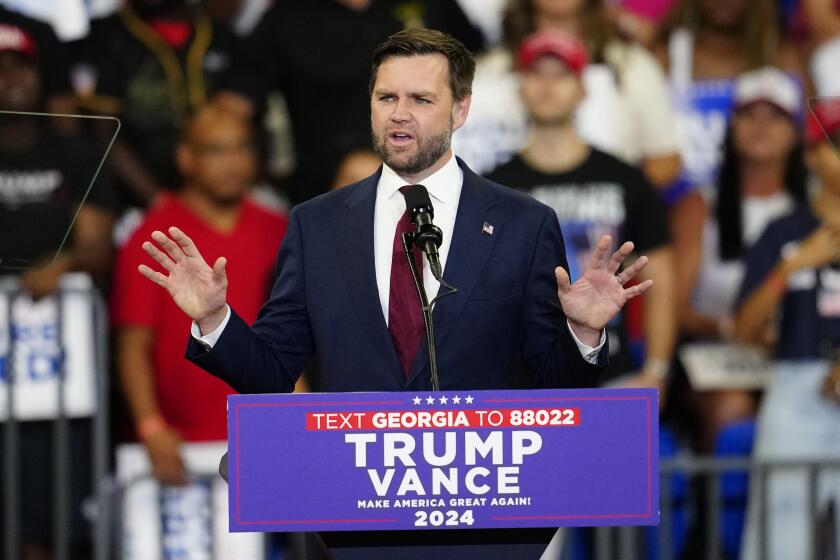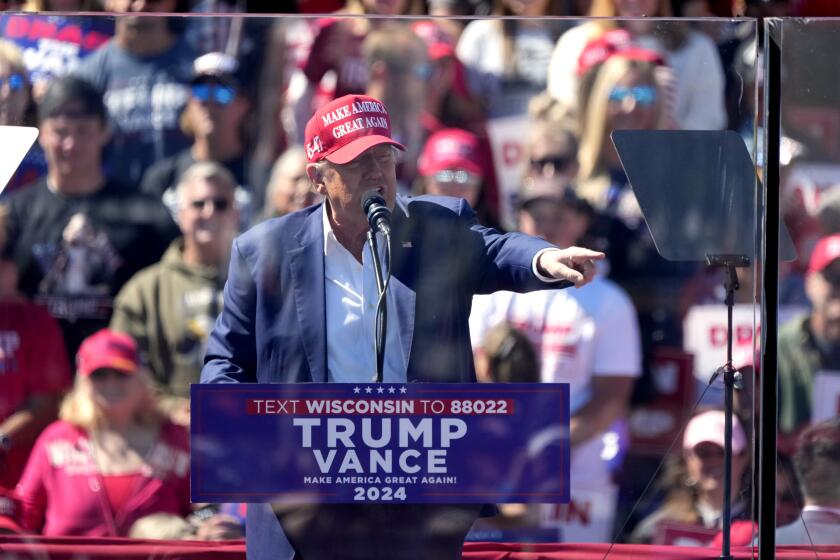Lawyers Pile On Evidence in Sniper Trial
After speaking his mind, John Allen Muhammad has retreated into silence. His blank face, half-hidden in a cupped fist, does not betray him now.
A parade of witnesses who said they glimpsed Muhammad and the car he drove have already constructed a powerful circumstantial case in the Washington-area sniper murder trial. Prince William County prosecutors have in two weeks raced more than 75 witnesses through their testimonies, and Muhammad’s attorneys have had little success in discrediting their stories. More will be called to the stand this week.
Taking over after Muhammad acted as his own lawyer for two strange days, the sniper suspect’s defense team has also had to contend with 300 exhibits of government evidence, ranging from the alleged murder weapon and Muhammad’s blue Chevrolet Caprice to DNA and fingerprint evidence.
Only the prosecution’s lack of eyewitnesses to the killings has given Muhammad, 42, a glimmer of a chance. Prosecutors have acknowledged that many of the rifle shots probably were fired by Muhammad’s co-defendant, 18-year-old Lee Boyd Malvo.
But legal observers said that the horrific nature of the sniper killings and their number -- 10 slayings in the Washington area and three more in the deep South -- had created an atmosphere in which jurors would be more willing to accept indirect evidence of Muhammad’s guilt.
“It’s a circumstantial case, but it’s a strong one,” said Steven D. Benjamin, a Richmond lawyer and president-elect of the Virginia Assn. of Criminal Defense Lawyers. “By stacking up the bodies at Muhammad’s feet, the prosecution is lessening its dependence on direct eyewitnesses. When you have so many victims, the sheer number has to have an effect on a jury.”
Each day inside the narrow Virginia Beach courtroom, the sniper killings are repeatedly evoked by prosecutors who have designed a strategy both understated and graphic: In voices etched with heartbreak, loved ones recall the dead. Old snapshots of the victims are shown, brimming with life, then contrasted with grisly crime scene and morgue photos.
Witnesses recall sighting the old blue Chevy junker parked near crime scenes. Some nod at Muhammad as identification. Some pick out the younger Malvo, who is being tried separately but has been called into court for identification by witnesses. Forensic evidence -- from ballistics matches to telling DNA and fingerprint traces -- has been kept mostly offstage, but is expected to emerge this week.
The prosecution’s most crucial sightings bracket the Oct. 9 killing of civil engineer Dean H. Meyers at a northern Virginia gas station. Muhammad is charged with Meyers’ death-- and if convicted, he could face death by chemical injection.
Muhammad’s rambling two-day stint as his own lawyer at the trial’s start appears to have wounded an already uphill defense case, legal observers now say. When the 1991 Gulf War veteran blurted out during his opening remarks that he was at the crime scenes -- insisting only “I know what happened” -- Muhammad aided prosecutors who needed to place him in close proximity to the slayings.
“He did the prosecution’s job for them, made it that much more difficult for his lawyers to question the testimony of prosecution witnesses tying him to those murder scenes,” said William B. Cummings, a former U.S. attorney for Virginia who is now a defense lawyer in Alexandria.
And by failing to make any emotional appeals to the jury while “giving a very controlled presentation” as his own lawyer, Muhammad may also have reinforced the prosecution’s claim that he was the mastermind behind the slayings, he said.
That could speed a death sentence if he is convicted. Under Virginia law, jurors first decide on Muhammad’s guilt or innocence. If they convict him, they then have to decide in a second “punishment phase” whether to sentence Muhammad to death or life in prison.
“He looked the jury in the eye, and he left them with a black-and-white choice,” Benjamin said. “If the jurors find him guilty of murder, that means they will have taken his own statements as a complete lie.”
The prosecution is seeking the death penalty against Muhammad by using two murder counts in the slaying of Meyers that address separate theories. Under one count, Muhammad is charged with committing more than one murder in a three-year period. To win that count, prosecutors have to prove Muhammad pulled the trigger.
Although prosecutors acknowledged in opening arguments that they do not have that direct evidence, they argue that Muhammad was, in essence, the triggerman because he allegedly created the plot and gave Malvo the means to fire the rifle.
“They are arguing Muhammad was a principal killer in the first degree by using Malvo as a killing tool the same way he would have used an assault rifle,” Benjamin said. “It’s a novel interpretation.”
The prosecution separately charged Muhammad with committing a terrorist act in the death of Meyers. That crime is punishable by death if prosecutors convince jurors it was committed to inflame public fears or influence the government. Last week, prosecutors tried to satisfy both requirements with the testimony of several witnesses who told of the widespread panic in the Washington area and others who described the snipers’ attempts to ransom $10 million as payment for ending the killings.
The prosecution team, led by Prince William County Commonwealth Atty. Paul B. Ebert, has moved methodically and somberly. Ebert and prosecutors James A. Willett and Richard A. Conway are veterans of capital punishment cases, accustomed to playing to rapt, conservative Virginia juries.
At times, they have cagily trapped the defense. During one exchange last week, Willett extracted routine testimony from Jeffrey Miller, a sniper task force detective. Miller had been used repeatedly to estimate the distance of the “kill shots” from the Bushmaster .223-caliber rifle allegedly fired by Malvo.
As he testified about the Oct. 3 killing of Sarah Ramos, Miller pointed to a photograph of a white car in a Maryland parking lot. Estimating the distance from the car to Ramos’ body was 89 feet, Miller was challenged by Peter D. Greenspun, one of Muhammad’s lawyers.
When Miller stepped down, Willett brought on a witness who testified that she had seen Muhammad’s Caprice sitting in the same spot where the white car had been parked. As the woman spoke, Willett glanced icily at the defense table.
Greenspun and co-counsel Jonathan Shapiro also have gone on the offensive, at times persuading Circuit Court Judge LeRoy F. Millette Jr. to bar the introduction of some government evidence. Shapiro is deferential where Greenspun is clinical, but both have walked a tight line trying to undercut the credibility of prosecution witnesses without alienating jurors.
It can be a difficult dance, such as the moment when Greenspun tried to shake the account of a Fairfax policewoman who said she saw Muhammad’s Caprice while driving home from a restaurant.
“I have to ask this, officer, but were you drinking that night?” Greenspun asked. She admitted to having had three beers.
The defense team’s return after Muhammad seized control of his case for two days quickly led to an upswing of objections. The interjections slow the pace of the trial, but they are essential for Muhammad’s lawyers to pave the way for a possible appeal.
“Now that Muhammad’s not representing himself, we’re seeing the trial going along a more predictable pace,” Benjamin said. “We’re watching a group of lawyers at the top of their game.”
Some of their testiest exchanges have come over the sightings of Muhammad, Malvo and the blue Caprice. Many witnesses have admitted reporting their sightings to police only after Muhammad’s arrest -- a point that defense lawyers have repeatedly stressed to jurors in questioning the accuracy of those accounts.
A northern Virginia bank manager testified that she saw both Muhammad and Malvo sitting in the Caprice not far from the gas station hours before Meyers’ killing. And a chastened policeman recalled that minutes after the shooting, he let a “courteous and polite” Muhammad leave a parking lot just yards from where Meyers lay dead.
Not all of the sightings are equally credible. A Maryland chiropractor told a gripping tale of staring down Muhammad and Malvo at a crossroads near where 13-year-old Iran Brown was wounded by sniper fire.
But the doctor began to scowl as Shapiro quietly shredded his testimony.
It turned out the witness had also reported one of the thousands of white van sightings that vexed police. And he had claimed to have seen a youth who looked like Malvo a month before the shootings -- when the teenager and Muhammad were still allegedly in the deep South.
“When your life changed that day, did you continue to drive through that intersection?” Shapiro asked sarcastically.
“Yes,” the chiropractor muttered, thoroughly beaten.
More to Read
Sign up for Essential California
The most important California stories and recommendations in your inbox every morning.
You may occasionally receive promotional content from the Los Angeles Times.










